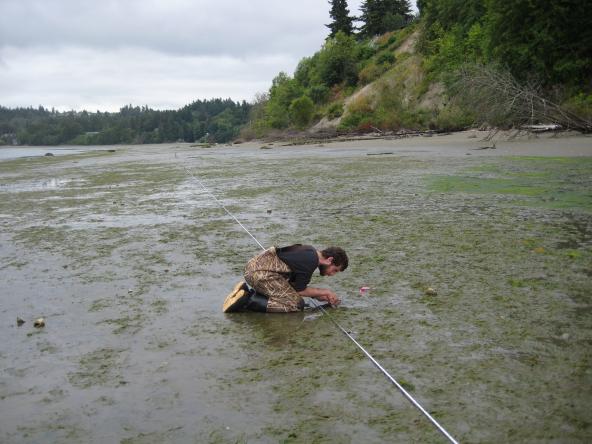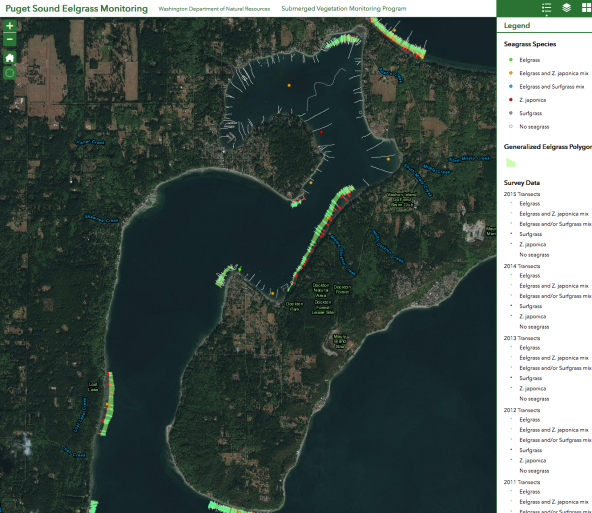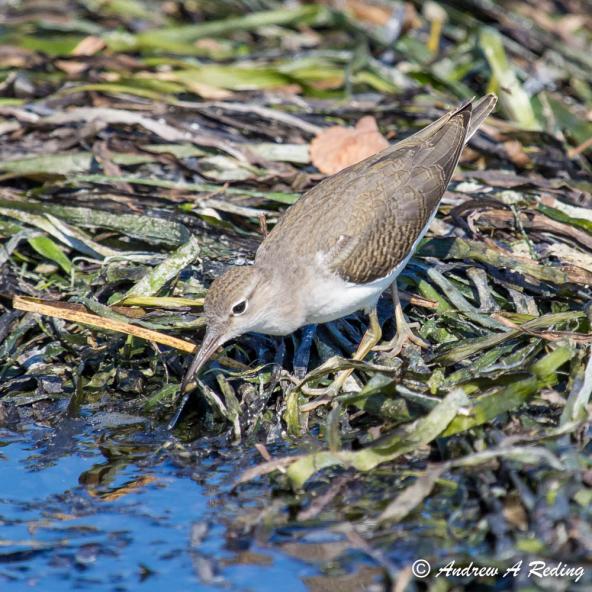
Scientists want to know why eelgrass is on the decline in some areas of Puget Sound and not others. The answer will affect future strategies for protecting one of the ecosystem’s most critical saltwater plants.

The Hood Canal, a narrow fjord extending from Puget Sound into the Olympic Peninsula, is home to salmon, crab, and a host of marine life. Walk along a tidal flat in the lower Hood Canal, and you may see a carpet of slick green shoots covering the shore. Until recently, eelgrass (Zostera marina) had been on the decline here, so its rebound is good news. But not all shoreline areas have the same good fortune — and scientists are struggling to explain why.
Eelgrass not only provides nursery habitat for fish and food for invertebrates; but also stabilizes sediment, absorbs carbon and nitrogen, and filters harmful bacteria. That’s why the state designated it a vital sign of ecosystem health, with strategies for meeting 2020 targets of increasing eelgrass extent or acreage by 20%.
Earlier this year, scientists from the National Oceanic and Atmospheric Administration, the University of Washington, and the Washington Department of Fish and Wildlife reported that the eelgrass population in Puget Sound has remained stable for forty years. Local declines were noted but why some regions experienced these declines when other areas did not, or even grew in numbers, is a mystery. Scientists say that raises concerns about eelgrass health at the local scale.
“One possible misinterpretation of that paper [would be to say] that we're fine if eelgrass is stable sound-wide. But that ignores locally significant declines,” says Matt Goehring, Aquatic Policy Analyst for the Washington State Department of Natural Resources (DNR). "And we don’t have conclusive evidence pointing toward which stressors are contributing to observed declines," or the relative magnitude of their impacts, he said.
Scientists across the Northwest are trying to figure out not only what affects eelgrass but also how well restoration projects and management practices work.
Something in the water?
East coast estuaries conclusively point their finger at pollutants from agricultural activities, septic systems and wastewater that create turbid waters and shade out eelgrass. There, it’s simple to show exactly what causes an eelgrass population to decline: when a pollutant source is removed, the eelgrass comes back.
Puget Sound is experiencing an increase in pollution as more people move to the area. Septics and wastewater can lead to an increase in so-called ‘nutrients’ that spur harmful algae growth, but so far, it is not clear if this is changing local eelgrass populations. Puget Sound also receives marine-derived nutrients from cold upwelling in the Pacific Ocean, and big doses of land-based nutrients from our largest rivers. Currents within the Sound in turn create a complex environment that move nutrients and pollutants around the estuary.
“Research globally has demonstrated that seagrass can be impacted by excess nutrients. We do not have a good understanding of the effects of nutrient loading on eelgrass in Puget Sound,” says Bart Christiaen, seagrass scientist at DNR.
Links between other possible threats and eelgrass declines are similarly ambiguous. Scientists are looking at a variety of potential impacts, from eelgrass wasting disease to shading from overwater structures to boat propellors and dredging. So far, no single factor stands out, and scientists say each eelgrass meadow or patch may be experiencing different impacts.

Population surveys
Knowing where eelgrass is and how it is doing locally is at least a first step toward gauging the problem. Since 2000, DNR’s Aquatic Resources Division Nearshore Habitat Program has been watching eelgrass populations across Puget Sound. Annual surveys from May through September use underwater cameras to characterize the abundance and distribution of eelgrass throughout the Sound based on a random sample of sites.
The survey provides information by which to understand the complex variety of factors that affect the eelgrass population along with helping to identify which management strategies offer the best hope for success. A recent report on DNR’s 2015 dataset, for example, suggests that eelgrass beds near heads of inlets and bays are particularly vulnerable. Unfortunately, still to be determined is what is behind their decline.
Part of this program’s goal is to explore ways to restore areas observed to be undergoing an eelgrass decline. While eelgrass at Quartermaster Harbor in southern Puget Sound has been there historically, it’s been absent from the inner harbor since 2012. But recent improvements in water quality count as a victory for state and federal agencies, and justify new restoration efforts. This summer, biologists will test transplanting eelgrass. If the transplants are successful, they’ll carry out a larger scale project in the future.

Conserving and maintaining existing eelgrass populations is easier and better than replacing damaged plants. Ron Thom, Coastal Ecosystem Research Group Leader at The Department of Energy’s Pacific Northwest National Laboratory, led a modelling effort based on historical data to identify sites where eelgrass restoration is most likely to be successful. They concluded that planting for mitigation is far less effective than protecting existing eelgrass and reducing stressors.
The shellfish factor
Concerns over eelgrass declines have also shone the spotlight on shellfish aquaculture. The shellfish industry in Washington State includes areas suitable for native eelgrass among the private or leased tidelands used to grow their crops. This overlap sets up the possibility for shellfish aquaculture to act as a stressor for eelgrass, but also introduces opportunities for modified practices that reduce damage to eelgrass populations.
“One advantage of talking about eelgrass response to aquaculture is that eelgrass stays put, unlike fish, and makes it easier to draw some conclusions,” said Jennifer Ruesink, zoologist at the University of Washington.
“One advantage of talking about eelgrass response to aquaculture is that eelgrass stays put, unlike fish, and makes it easier to draw some conclusions,” said Jennifer Ruesink, zoologist at the University of Washington. Small-scale effects could come from different aspects of shellfish aquaculture, including space competition with shellfish, shading or sediment change from structures, or disturbance from harvest.
Shellfish also compete with eelgrass for space. And the reduction in light from shellfish bed structures is sometimes, but not always, associated with reduced eelgrass populations. Low-density structures in shellfish farms can increase water flow and therefore scour sediments. But high-density structures may increase sediment deposition, which reduces eelgrass growth. Digging and dredging activities for these farms immediately reduce eelgrass density. But then eelgrass can respond to the reduced density by enhancing its seed production or branching.
A management issue for Puget Sound is how to strike a balance between the different types of aquaculture and their impact on native habitat. An added complexity to this discussion is that in Washington, eelgrass is highly variable and has poorly understood genetic diversity so that it doesn’t make sense to treat eelgrass the same in every location. “This begs the question of whether eelgrass traits may respond the same or different to coastal activities,” says Ruesink.
Building on Ruesink’s studies of local-scale effects, ecologist Brett Dumbauld at the USDA’s Agricultural Research Service collaborates with the Pacific Shellfish Institute to investigate how oyster aquaculture affects eelgrass at the seascape scale. With aerial infrared photos and GIS data of Willapa Bay on Washington’s Pacific Coast, his team is building a model to assess how seagrass will respond to proposed shellfish aquaculture activities.
With 8% of the bay’s intertidal area devoted to oyster aquaculture and 35% of that covered in eelgrass, Dumbauld and Ruesink want to quantify the total impact of bivalve aquaculture on eelgrass. They suggest that oyster aquaculture reduces eelgrass presence at the landscape scale in Willapa Bay, but only by less than 1.5%. This largely neutral effect may occur because shellfish aquaculture stabilizes sediment on farms through removal of bioturbating shrimp, which can then be colonized by eelgrass, even while directly removing some eelgrass in other areas.
“Are the effects of aquaculture chronic or transitory from one year to the next?” asks Dumbauld. Studies show that most beds have the predicted amount of eelgrass present, with low variation between years. Shellfish harvesting method, whether mechanical or by hand, has been found to have the most impact, with mechanical harvesting associated with chronically low presence of eelgrass. Results of Ruesink and Dunbauld’s work will help to inform the permitting process for construction in the Sound.

Dredging for answers
Better monitoring and rigorous studies of individual stressors will gradually lead to a better understanding of Puget Sound eelgrass. But cause and effect still perplex scientists.
Despite the uncertainties, the best available science is getting better, and with it, hopefully better regulatory practices and mitigation efforts.
Laura Hoberecht, Aquaculture Coordinator at NOAA's Fisheries Service, pressed scientists to ask “How would you apply your shades of grey in a black and white [regulatory] world? And, regulators, how could you incorporate science into your management?”
The only certainty is that it’s not going to be easy. Science, industry, and management alike need to work together to formulate the best possible evidence-based policy for conserving this vital plant.





